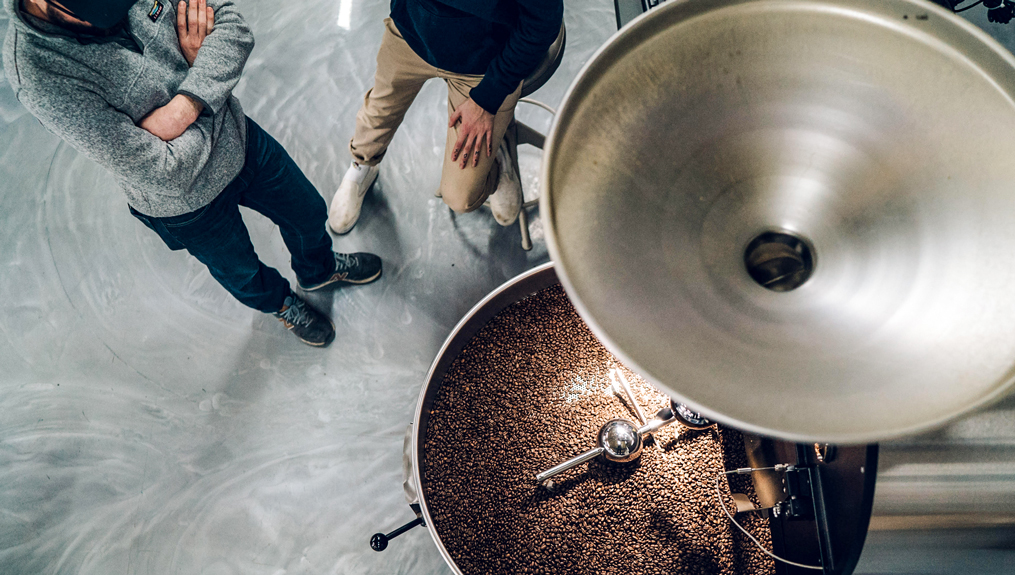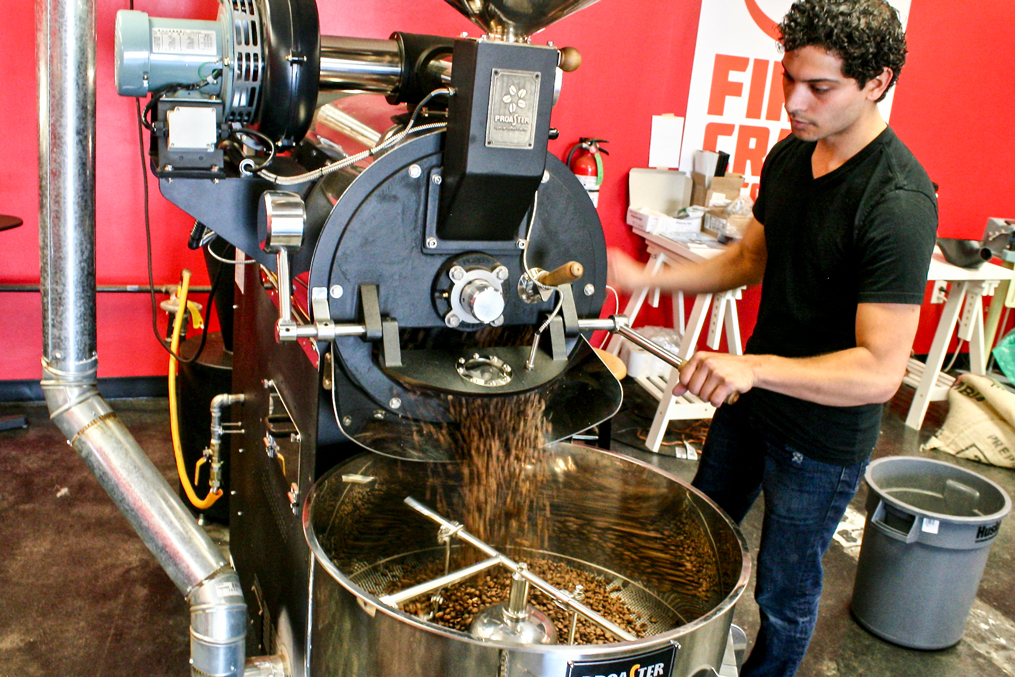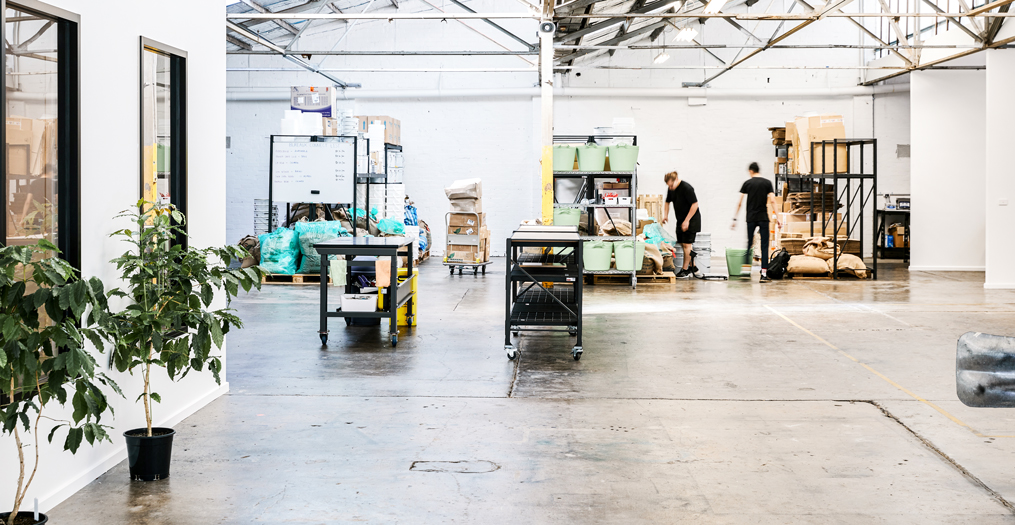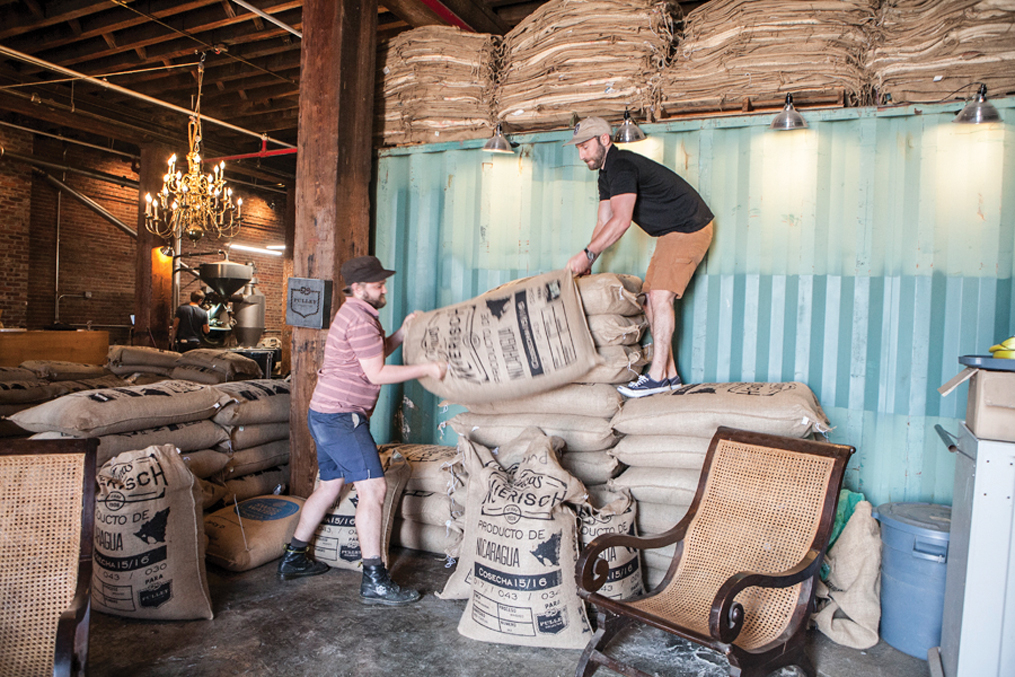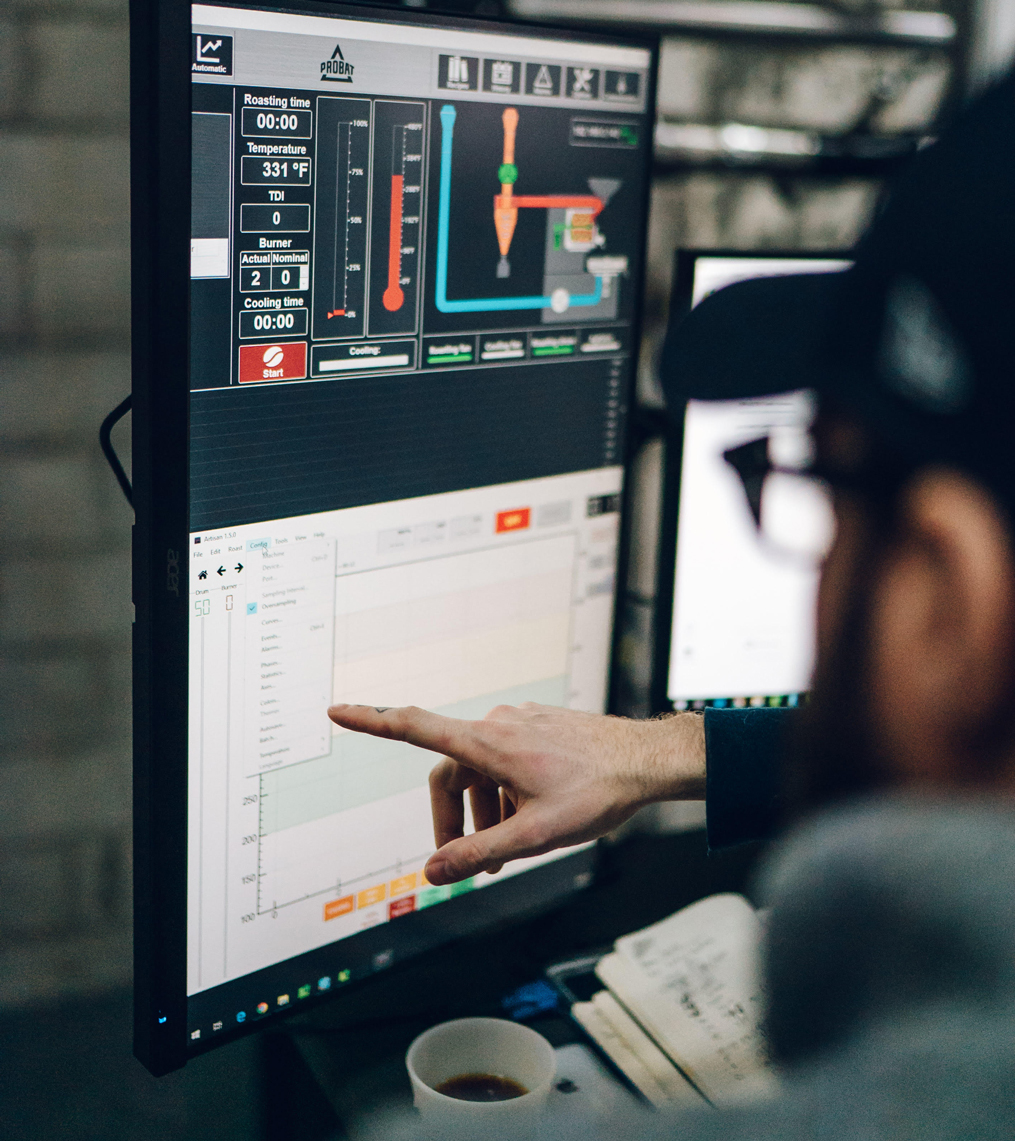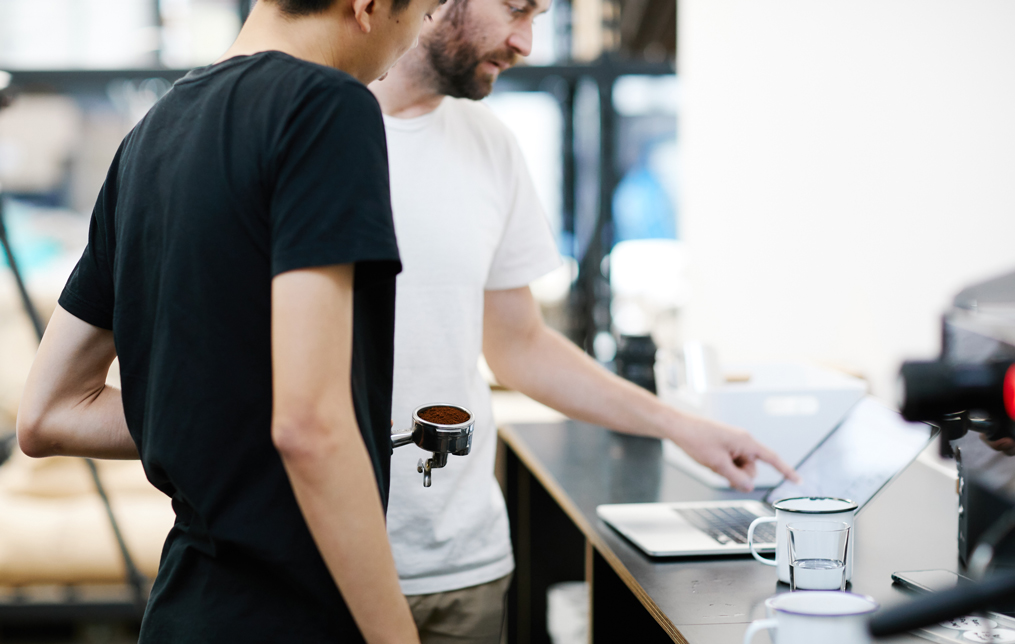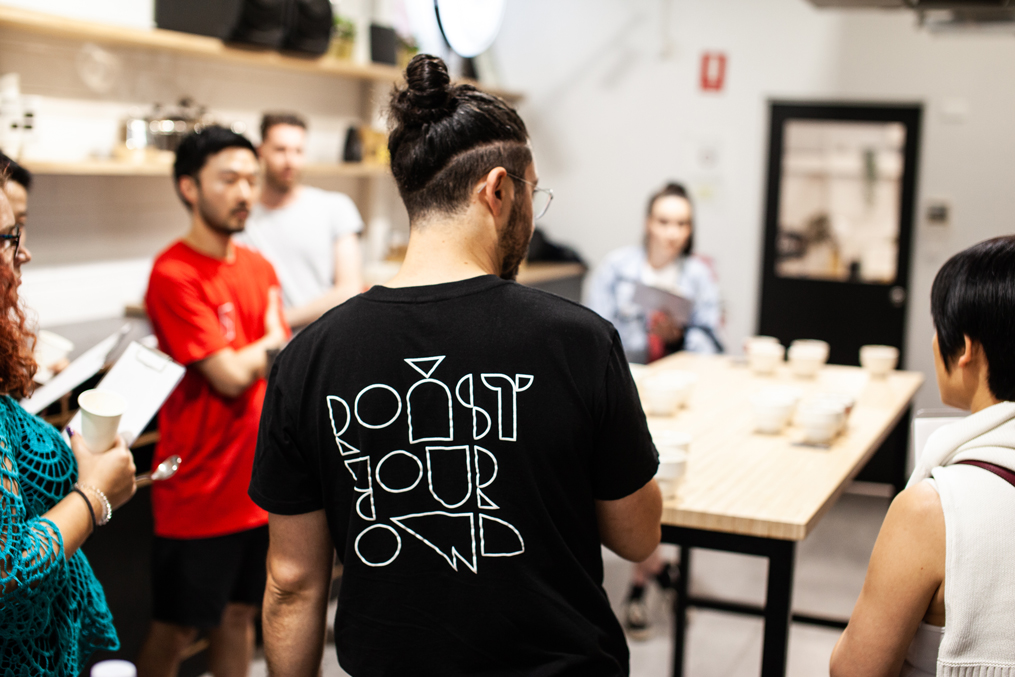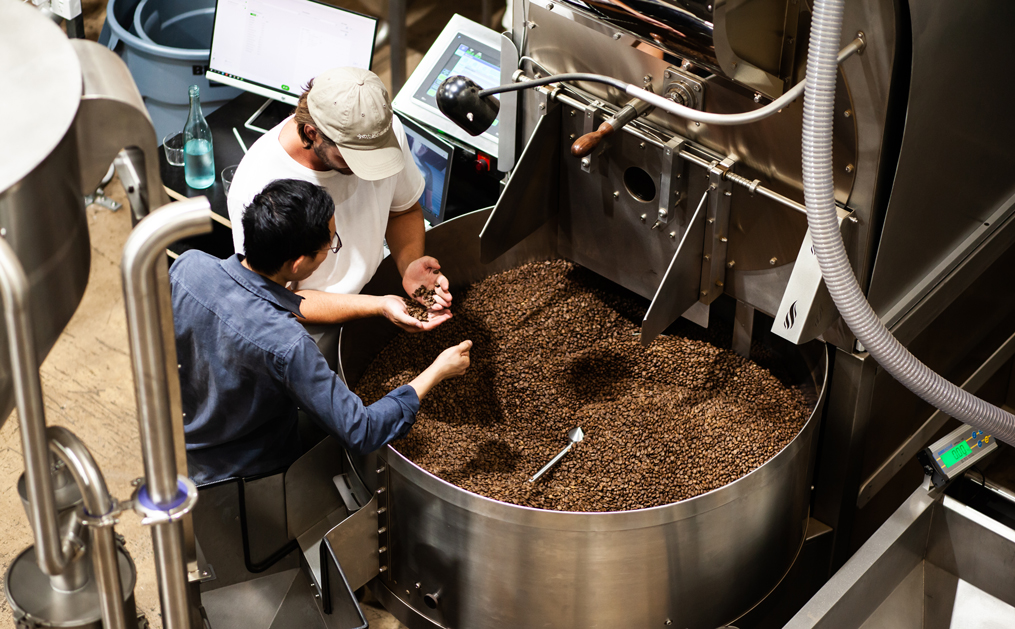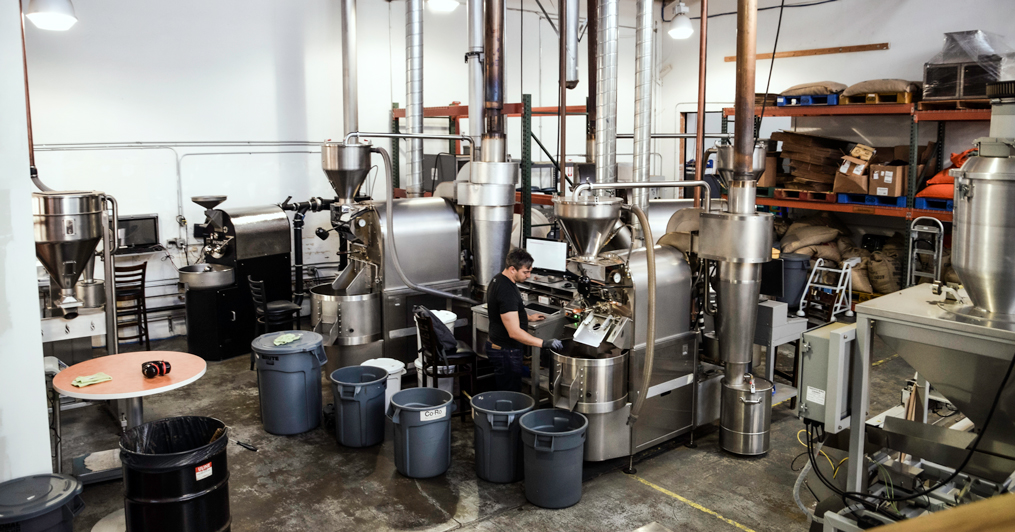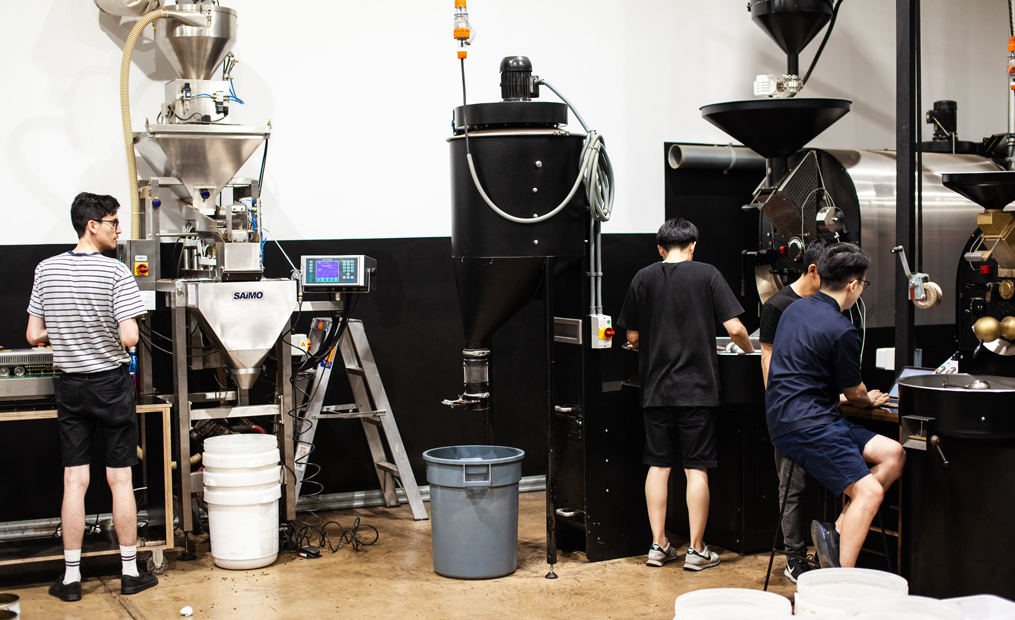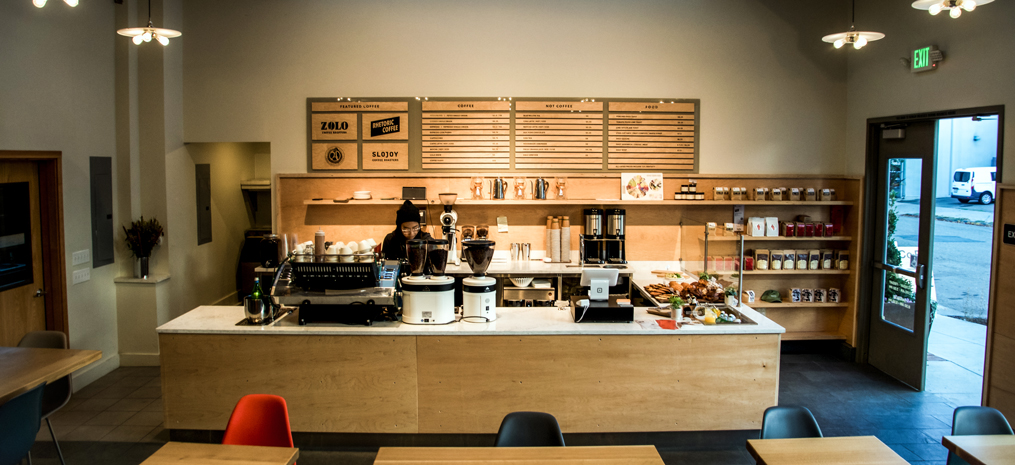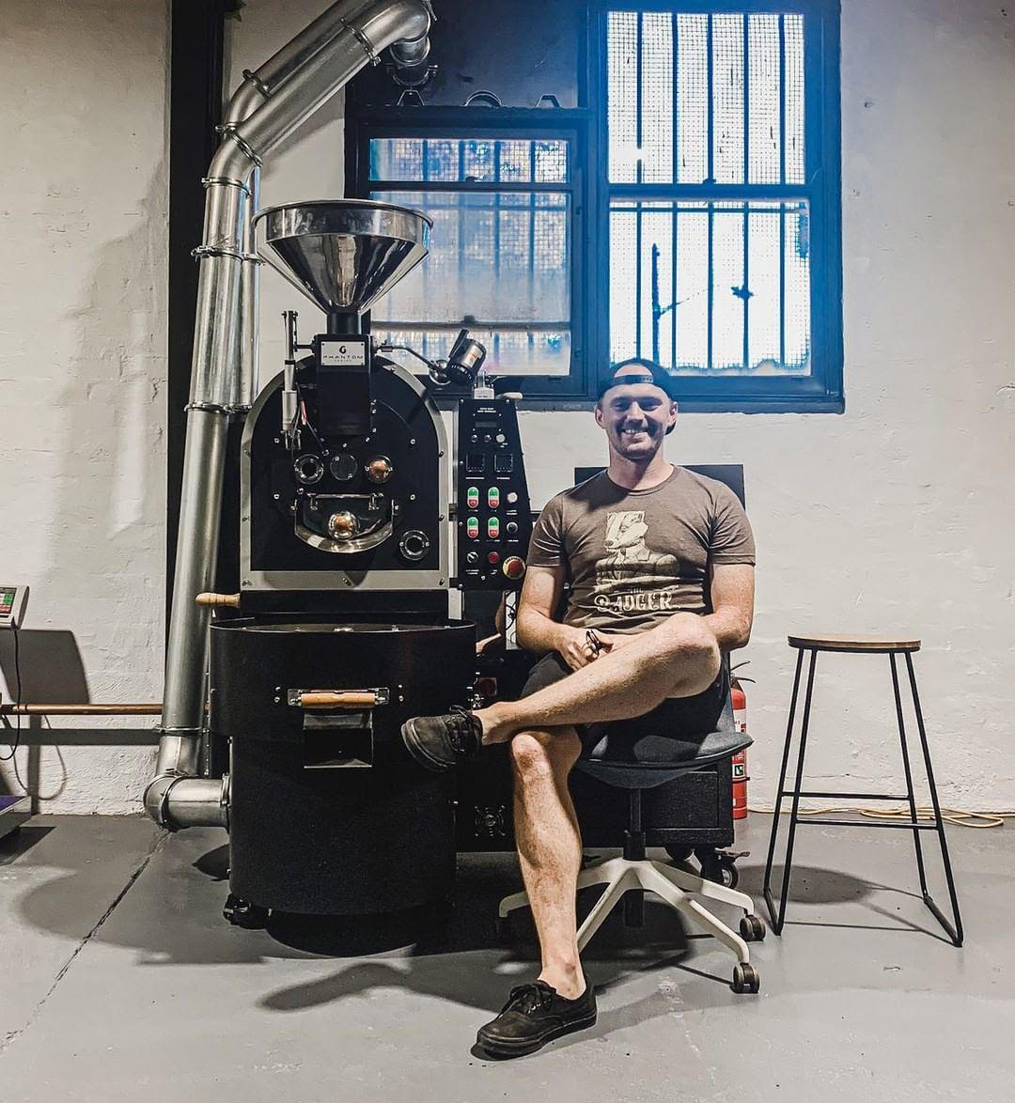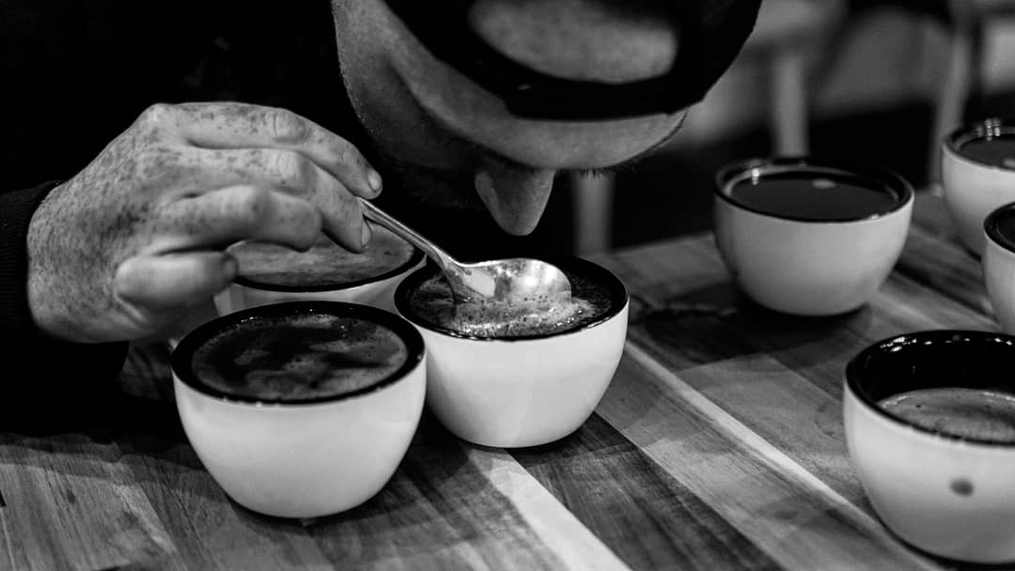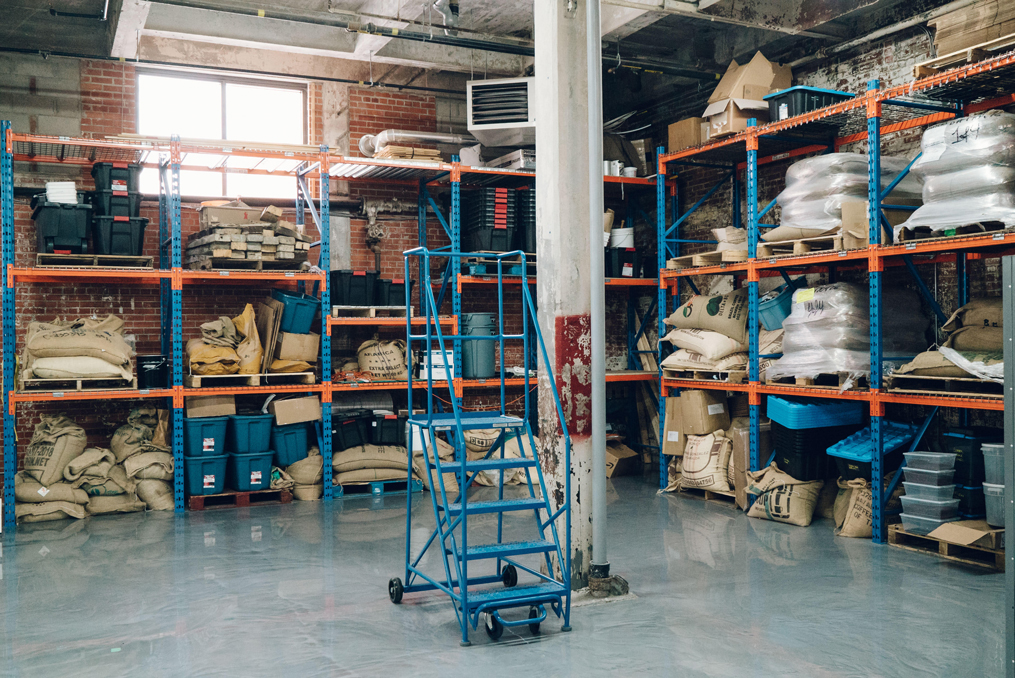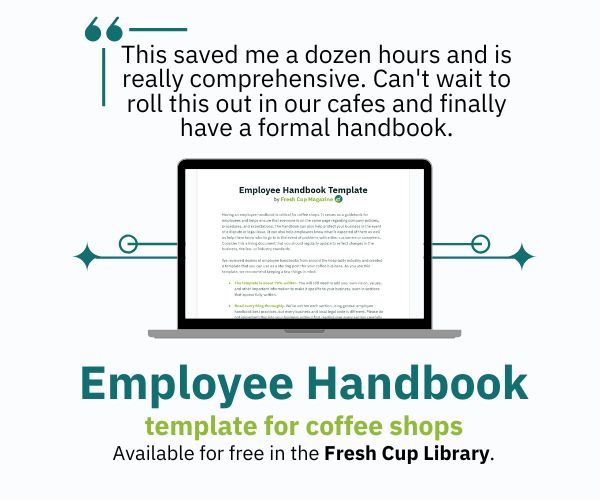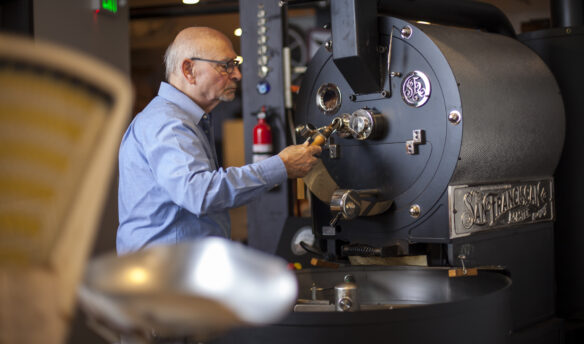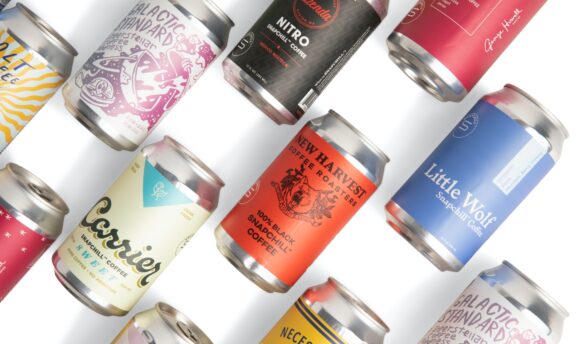Probat roaster in use at the Canadian Roasting Society in Montreal. Photo by Andrew Rizer
[N]eil Suthar wanted more control over his coffee program. He wasn’t unhappy with the coffees he had from a couple of local roasters. And his shop, Foundation Grounds, had experienced plenty of success as a neighborhood anchor in the thriving St. Louis suburb of Maplewood, Missouri, both before and since he took ownership in 2016.
Still, he wanted that ownership to extend further. When presented with the opportunity to begin roasting for Foundation Grounds—without purchasing either a roaster or a place to use it—he couldn’t pass it up.
In October 2017, Suthar was approached by Collin Bay, co-owner of First Crack Coffee, a St. Louis-based Proaster distributor that had recently opened its doors to local roasters to share time on its machines.
“We were inspired by the ability to have direct ownership of the sourcing and roasting process, and to be able to provide our customers a unique product that is specific to our coffee program,” says Suthar. He decided to give it a shot, and Foundation Grounds has maintained its own coffee brand ever since.
Suthar is just one of many in North America to make this leap in recent years, and First Crack is but one of the companies making it possible for shops like his to take roasting into their own hands.
The first of these “co-roasting” spaces, Aspect Coffee Collective, started sharing time on roasters at a Portland, Oregon-based home-roasting supply store called Mr. Green Beans in 2011. The concept has since given rise to more formal business models and spread to other coffee hotspots in New York, Los Angeles, the Bay Area, Montreal, Miami, and now St. Louis.
The specifics vary, but all of the spaces essentially offer small cafés or roaster startups the chance to enter the roasting game without the typical entry fees. They’re also enhancing coffee communities throughout North America, as new, small roasters are born in highly collaborative environments.
The community-driven concept has also made its way down under. Catering to the Aussie coffee market, the co-ops provide businesses with more scope for creativity and control. Places like Bureaux Collective, Collective Roasting Solutions, and Specialty Coffee Curators serve as incubators for emerging coffee brands, while also educating the next generation of coffee enthusiasts.
For Melbourne-based coffee institution Patricia Coffee Brewers, joining Bureaux Collective has been the right business decision.
“We love it, and it’s been a great new skill for me to learn,” says Pip Heath, co-owner of Patricia. “Over the three years, I feel like I’ve gotten more into [roasting], and…it has helped our business.”
The model is less than a decade old, but it’s spreading quickly and changing the coffee market. As more small companies enter this previously out-of-reach trade, they are finding some major advantages to using these shared facilities.
Putting Roasting Within Reach
For most shop owners or other coffee professionals considering launching their own roasting operation, cost presents by far the biggest barrier.
“Roasting machines, permitting, and all of the equipment needed can easily put a company over $200,000 in the hole,” says Jen Apodaca, vice chair of the Coffee Roasters Guild, director of operations for Pulley Collective’s co-roasting space in Oakland, California, and founder of new company Mother Tongue Coffee. “Starting your business with shared equipment helps many companies get through those first rough couple of years.”
The unfettered access to equipment and other resources was enough to convince David Boucher and his partners Marc Séguin and Josh Gieni to pivot from their original plan. When they were planning the launch of Escape in Montreal, they met Andrew Kyres and toured Canadian Roasting Society (CRS), his new co-roasting space.
“When we met Andrew, we were actually going to buy our own equipment,” recalls Boucher, “until I walked into the CRS to meet him—the space and the equipment was just amazing, we couldn’t afford to even think about having such setup.”
That setup includes two new Probat roasters, a P12 and P25/2, equipped with Pilot and Artisan software for roaster control, and Cropster for data logging. CRS members also have access to a fully equipped cupping lab, a weigh-and-fill and sealer for bagging, and space to store pallets of green coffee. Kyres even builds brewing water from scratch every week, providing a highly controlled environment for cupping and quality control.
All of this is available to roasters when they pay an hourly rate for roasting time, plus a storage fee for using warehouse space. It amounts to between 0.50-1.25 Canadian dollars (roughly $0.40-1.00 USD) per pound, a cost more easily built into the business than a massive up-front purchase.
“Rather than needing $150k or something to get a small roastery going, you can walk in with zero dollars, and that’s fantastic,” says coffee consultant and author Scott Rao, who partnered with Kyres in launching CRS in November 2018, and provides training for members. “If you do have a bit of a budget, you can put some of that money towards marketing and other things for the business.”
Drawing inspiration from Brooklyn-based Pulley Collective, Melbourne’s Bureaux Collective, led by Tim Varney, who worked at Tim Wendelboe in Oslo, and Tim Williams, who formerly worked at Workshop Coffee in London, was one of the first spaces to open in Australia in 2016.
“I wanted to do something that would democratize the access to roasting,” says Williams. “Make it available for café owners and baristas to get involved, without having to spend five years at a company or 10 years working the floors.”
Bureaux looked at the craft beer industry, where beer would be brewed using someone else’s equipment and then paid by time or volume.
“Not everyone needs a five-hundred-piece tool set seven days a week,” says Williams. “They need one or two tools, one day a month. And the same is true of coffee. But no one else in the industry jumped into that.”
Having worked as baristas in Melbourne, Varney and Williams already knew café owners and friends who owned cafés and thought about roasting.
“But no one had given them the structure to do it,” explains Williams. “We went to cafés and said, ‘If you want to start roasting your coffee, we will do all the back-of-house stuff.’”
That includes finding premises, roasters, and green coffee, and providing training—companies would simply come in, roast their coffee, and pay for the time used on the roaster.
The first four coffee brands Bureaux approached—Patricia Coffee Brewers, Everyday Coffee, Assembly Coffee & Tea, and Wood & Co., which also happen to be some of Melbourne’s top coffee leaders—signed on. Now, Bureaux has over 30 members, and is continuing to grow.
“We’re excited to see great coffee and passionate people. That seems to be the kind of clients we work with,” says Williams. “Our pricing and how we’ve set up predisposes a certain type of café wanting to work with us.”
Generally, a café will approach Bureaux for reasons such as wanting to diversify their coffee offerings, the roaster has increased their prices, or they are after more consistency. Then, Williams and the team talk to the café owner about what they want to achieve, and a plan is put together on what green coffee to buy and how to roast it.
“It’s not particularly complicated,” says Williams. “The coffee industry has done a good job of making [roasting] seem complicated so that people don’t undertake it. But we can have people up and running within a few weeks.”
Loans, organization, and running a whole roastery seven days a week were elements that deterred Patricia co-owners Pip Heath and Bowen Holden from opening their own space to roast.
“When Tim Varney and Tim Williams approached us with this idea and asked for advice, we thought it was perfect,” says Heath. “We said, ‘We’re behind you on this.’ We were pretty confident it was going to be awesome for us. But it was even better than we thought.”
The main advantage of the space was that Heath and Holden would be able to finally learn how to roast coffee.
“We would have Tim Varney to teach us to roast. He has a great deal of experience with roasters. And we could do that without any massive outlay of money,” says Heath. “For us, it was about having more control over the product that we had in our shop and just the excitement of learning how to roast. And doing that pretty risk-free.”
Sydney-based Collective Roasting Solutions (CRS) founder Nawar Adra explains that if you are a 50-kilo café and you want to roast yourself, you might buy a five-kilo roaster and put it in a warehouse.
“It would cost for return on investment around A$12 to A$15 a kilo,” he says. “But if a 50-kilo café came to us, it’s only going to cost A$6 a kilo, without pulling anything from the pocket.”
While there are variations in how each co-roasting space structures its pricing model, the end result is the same for any roasters involved: it puts greater control over their coffee program within reach.
“We have made it so easy,” says Adra. “All we want from café professionals is to focus on good coffee. Buy great coffee, roast it well, focus on it….They don’t need to worry about maintenance or cleaning. Grow your business by doing the right thing. Then, go to the next step. Do what you need to do. Just make great coffee.”
Access to Education
The material benefits of these spaces are far from the only draw for aspiring roasters. In the co-roasting model, many owners are discovering a much quicker path to learning the trade.
Since its inception, Sydney’s CRS, which is home to 40 clients, has been focusing on building the next generation of coffee professionals through education. Last year, they ran 66 events, including cuppings, educational seminars, and competitions.
Founder Nawar Adra says the next step is to open a CRS Academy. Along with education, the academy will provide accessibility and tools for students wanting to compete.
“We will buy the same machinery and water filtration and give new baristas, brewers, whoever wants to compete, an opportunity,” he says. “They can come and do a rehearsal, work on their competition act, and we will sponsor them. That way we can bring in new talent.”
The academy will be a space where different roasting ideologies are taught and welcomed.
“I’m happy to bring anyone,” he says. “I want to make it an institution.”
Pip Heath adds that one of the intangible benefits is having hands-on knowledge of more steps down the line—not just for himself, but for his staff, and, ultimately, the consumer. He brings his staff in on days he is roasting to show them the process, taste the coffee, and talk about sourcing—details they can in turn share with Patricia customers.
“It is such an opening up of the product,” he says. “I think that that’s got a lot of potential to affect the coffee industry in Australia and globally.”
For owners Collin and Bryndon Bay of First Crack Coffee, which opened its roasting space in January 2018, education is first priority. The brothers, who grew up in the music publishing industry, were new to coffee themselves when they originally sought to launch a wholesale roasting operation. They learned quickly through SCA courses, events, and other opportunities, eventually becoming SCA-certified instructors. That learning experience shaped their business model.
“I first and foremost identify as an education business and sales business,” says Collin Bay. “So it would be shortsighted and elitist to exclude people who are new and soliciting education.”
First Crack eventually became a distributor of a variety of smallwares and other equipment en route to becoming the exclusive North American distributor for South Korea-based Proaster roasters. But when it comes to persuading cafés to try out their services, the brothers’ focus has remained on education and support.
That emphasis has also been a primary selling point for Suthar and his team at Foundation Grounds.
“They’ve been more than generous with hand-holding through the entire process,” says Suthar. “They still continue to do so—that’s what makes it so important for us is that they provide this partnership and expertise for us so I can focus more on customer experience and running the day-to-day operations.”
Many of First Crack’s customers come in with little to no experience roasting. In addition to offering training on the roasters, support for green coffee purchasing, and consultation in the cupping lab, First Crack offers SCA classes à la carte.
“It’s awesome if it can be a community resource,” says Collin Bay. “We had two of our customers in here today who both independently used the term ‘empowerment’ because you’re giving people new skills, access to things that they couldn’t have before. If you used to be a café only, and now you roast your own coffee, you’re giving people skills and a means to support themselves that they didn’t otherwise have.”
Cultivating Collaboration
Education doesn’t only flow from the top down in these co-roasting spaces. In fact, much of the learning is gleaned from the collaborative environment they create.
Nurturing this communal spirit has been central to the success of Bay Area CoRoasters (CoRo for short), which Floy Andrews and Tim Hansen launched in 2016 in the space that was larger than what its original inhabitant, Supersonic Coffee, needed. Hansen says they specifically sought to model the business around collaboration, not competition. When they opened the space to anyone who wanted to launch a roasting business, Supersonic (later rebranded as AKA Coffee) was the first CoRo member.
For Andrews, it was about “having a space to come and connect with others around the thing they’re really passionate about.” She wanted to create coffee community, not merely rent out equipment.
“They learn from each other,” adds Hansen. “People share their information. It’s really kind of a wonderful environment.”
This has proven true for CoRo member Mike Weaver and his company, 3-19 Coffee.
“The community of roasters is a big bonus.…It’s nice to roast in a place that has a neighborhood and community feel,” he says. “It’s been great to get to know other roasters as every company and person has their own path and reason for being in coffee. Roasters benefit from being near competition, as we can all learn from each other along the way.” CoRo’s collaborative model is common among co-roasting spaces across North America. In many of these spaces, members cup each other’s coffees, share roast profiles, and provide feedback.
“[That’s the b]iggest advantage hands down: we taste way more coffee and roast profiles than any of our competitors,” says Boucher about his Canadian Roasting Society experience. “We cup everybody’s products, everybody’s productions, everybody’s sample roasts, everybody’s importing tests, etc. We would never have tasted that many coffees in this short period of time if we had done it by ourselves.”
While some roasters may prefer to keep more information private, Montreal-based CRS co-owner Andrew Kyres notices a difference in the ones who open up.
“The ones that are sharing are improving so quickly,” he says. “I think they’re seeing the benefit of an open, more socialized version of coffee roasting.”
For Sydney’s Collective Roasting Solutions, its main goals are to help coffee businesses grow, to ensure clients don’t leave for another co-roasting space, and to build respect and harmony across the industry.
“The roasters are not behind the curtains,” says Nawar Adra. “They are out there talking about roasting.”
Co-founder of Sydney’s Edition Coffee Roasters, Daniel Jackson, says roasting at a collective space such as CRS provides a platform for people to talk about issues, solutions, and innovations. Therefore, there is more chance of these things being tackled and changed. “Enabling more to be involved brings awareness to the coffee industry and some of the struggles that can be had in an industry we all love,” he says.
Disrupting the Industry
Collective spaces also provide an opportunity for café owners to question their situations: “What is this roaster doing for us, and what value are they bringing?”
Tim Williams says while many Australian roasters bring a lot of value, there are some who’ve gotten away with poor practices for a long time.
“[They] put questionable coffee in bags and ship it out, with café owners not having too much choice,” he says. “One of the impacts, we hope to have, is for mid-tier roasters to buck up their ideas to generate more value. Otherwise, café owners will go and do it themselves. And arguably, do it as well.”
For Sydney’s CRS, their mission is to be direct trade. They also hope to influence the coffee industry to bind together and not drop coffee prices.
“If café owners keep pushing prices down of a wholesale company, there will be a turning point, where wholesalers will start to use terrible coffee to give the market what it’s asking for,” says Adra. “If you are here to represent the farmer, then you need to look at scaling.”
With that in mind, coffee professionals need to say: “I want to have a wider audience. The more audience I have, the better the buying is, the more benefits I’m giving that farmer.”
By roasting at collective spaces and having access to technology to ensure consistency, coffee can evolve itself, and the price of coffee can go up.
“Then we can give the quality that we are meant to give,” says Adra. “We need to go back to the service. We need to start realizing we need to serve people better, and we need to make them feel comfortable.”
While collective roasting spaces are financially sustainable, they also have the potential of being more environmentally sustainable. CRS, for example, is looking into roasting equipment that has a better footprint.
Many of those who have started these spaces are seeking an impact that goes beyond all of these objectives, though.
“I wanted to see coffee shatter,” says Tim Hansen of CoRo. “Wine shattered a few years ago—it used to be there were just a few wineries. A few companies made the lion’s share of sales….There are now thousands of small wineries and more winemakers control their own economic future, they’re in better control of their lives, they are producing more creative and better wines, and those few big ones are no longer so dominant. So, we thought that if that could happen to coffee, that would be awesome. The quality of the coffee would go up, the number of people making a decent living would go up, and people would take control of their lives.”
These spaces have certainly sparked a proliferation of roasters in their markets, as many small cafés begin roasting for the first time. CoRo alone serves more than 20 members and between five and 10 customers who rent on an as-needed, hourly basis. For consumers in markets that support a co-roasting space, this means a wider array of coffee options.
For Steve Mierisch, the end goal of this market diversity reaches beyond the consumers. Mierisch opened one of the first co-roasting spaces, Pulley Collective in Brooklyn, in 2012 and has since added locations in Los Angeles and Oakland, California, but his roots in coffee extend beyond the U.S.
“I’m originally from Nicaragua. I grew up on coffee farms and know many coffee farmers,” he says. “The more coffee roasters that exist that can sell their coffee for $20 a pound in their coffee shops, the more coffee roasters will exist that can pay $4–5 a pound for green, making farming more sustainable when these roasters practice responsible and transparent green buying.”
Pulley Collective’s Brooklyn location opened its doors with around five members seven years ago. Today, the location boasts between 25 and 30 members, on top of a number of high-profile alumni that have since gone out on their own, including Parlor Coffee, Ninth Street Espresso, and Noble Tree.
“Multiple small roasters on offer in one city reinforces the feelings and knowledge that coffee is an agricultural product produced by humans,” says Steven Sadoff, founder of NYC’s Ground Support, a Pulley Collective member. “When you only see a few large roasters across a dozen stores, coffee feels like it’s supplied by a few factories, thereby contradicting what attracts so many of us.”
A More Inclusive Roasting Trade
Collective roasting spaces are also there for those who are done waiting—done waiting for someone to hire them, done waiting for someone to offer them a chance to upskill. It’s about taking control of one’s coffee journey, and, ultimately, career.
Situated in Sydney, Specialty Coffee Curators was formed after teaming up with an investor, Espressology. The idea came from seeing the growth of communal companies such as Uber and WeWork.
“I thought, ‘Why can’t we make coffee beans accessible?’” says founder Caleb Holstein. “We wanted to provide a space where there would be some industry structure.”
Holstein wanted to open the coffee industry to provide a gateway for people to access the best coffee, to understand it, and not to feel intimidated by it.
Specialty Coffee Curators is a communal training facility, where Holstein and his team help coffee professionals run training courses. There is also a shared office, which can be utilized by those wanting to start their own business.
“We are the incubator and platform for them to create,” he says. “We’re not experts. We’re just giving people space and a supporting network.”
One of their current members is Black Market Roasters, who uses the space to roast as well as run their training courses. Black Market founder Angus Nicol says collective spaces make roasting accessible to anyone wanting to give it a go. They also help develop a community of coffee professionals who share ideas or hang out while chasing their own coffee goals.
“There are so many passionate people out there who want to learn,” says Holstein. “So I’m trying to make it more accessible and affordable.”
Along with increased accessibility, upskilling is one of the most significant advantages of these spaces.
“The higher end of the coffee industry is cannibalizing itself because we’re taking baristas from one store to the next to the next to the next,” says Holstein. “They are looking to upskill, and they don’t know where to go. And the easiest thing is to go do their job somewhere else.”
Specialty Coffee Curators is there to break down barriers and preconceptions of coffee roasting. It’s also a space where staff can upskill, and afterward, go and have a coffee together.
“It creates that sense of community in the business where everyone is brought in for the one product,” says Holstein. “We need more people to know about coffee, to understand and value our product. There are some fundamental issues in the coffee supply chain. It’s about valuing green coffee.”
For Kobi Morris, head roaster and café manager of Sydney-based Paramount Coffee Project (PCP), the opportunity to roast only came up around nine months ago when PCP decided to roast their coffee at CRS.
“We were looking for an impartial space to roast our coffee,” she says. “As we are a business co-owned by two Australian roasters, we were mindful of maintaining our brand. If we had started roasting in the Reuben Hills or Seven Seeds space, it would have been difficult to grow and develop our roasting style.”
Morris explains that the training programs make it easier for a barista to go on their own and learn to roast, or for a café to create more opportunities for their staff.
“I’ve worked as a barista for 14 years, but never for a company that roasted, until now,” she says. “It always seemed hard to learn how to roast without getting employment at an established roaster….Now, the idea that I could go into business on my own as a roaster through a collective space is empowering. And empowerment is essential in the hospitality industry, particularly for underrepresented people.”
Morris is not alone as a woman experiencing these benefits of empowerment, diversity, and inclusivity.
“Shared roasting spaces lower the cost of entry into the coffee roasting world for women and other marginalized people that are denied access to capital,” notes Jen Apodaca, who also founded #shestheroaster, an organization that exists to help self-identifying women in coffee become roasters.
Samantha Padilla experienced these benefits firsthand, thanks to First Crack. Although she had worked in roasters in San Diego in the past, that work had only consisted of production assistance outside of roasting. After moving to St. Louis, her opportunity to roast came unexpectedly while working as general manager for Kitchen House Coffee, a two-shop multi-roaster that wasn’t roasting its own coffee when she came on board.
When First Crack approached the owners of Kitchen House Coffee, they gave Padilla the opportunity to launch the program. She roasted for the company for 18 months before accepting a sales position with First Crack in June.
“It was definitely the only opportunity I’ve ever been given to be able to roast coffee,” says Padilla, whose background in nuclear engineering with the Navy made the science-heavy work of roasting a natural fit. “I don’t know if or when that would have ever been able to happen if it wasn’t for First Crack.”
Padilla also spent time last year at Re:co, where she met several female roasters, including some from #shestheroaster. In her short time roasting, she has already mentored several other women, including many who roast at First Crack, and is hoping to launch a St. Louis Women’s Roaster Alliance.
“I think it’s definitely becoming more known—the lack of women in coffee, especially in higher skilled or roasting jobs,” she says. “It could be really exciting to get to expand and hopefully get more females into roasting.…I think [places like First Crack] will open up a whole door of opportunity for a lot of underserved communities in the coffee world in general.”
Apodaca cautions that these companies can’t just expect this type of diversity to happen on its own, however.
“Although the door is open, shared roasting spaces still need to do work to encourage and invite women and POC into their spaces,” she says. “Just seeing women roast coffee can change the minds of people who previously thought differently and maybe encourage them to make their first non-white male hire on the production floor.”
A Trend in Development
Co-roasting spaces don’t come without challenges. Roasters have last-minute needs that demand scheduling flexibility. There are inevitable tensions that come in sharing a space with one’s competitors, no matter how collaborative the spirit. Growth limitations are also inevitable in a shared space with limited equipment and time slots for each member.
Kobi Morris says the only hurdles PCP faces is that of logistics, transporting coffee, and having a short time slot once a week.
“I use my own car at the moment but if we do more volume we might look at a van,” she says. “Also just having a short time slot once a week means it’s hard to really get to know the roaster, and all the variables like weather that can affect the roast.”
Additionally, with café owners now able to gain training, support, and more or less immediate feedback without much investment, there is the danger of cutting corners.
“I think [roasting co-ops] have the potential for people to cut corners and go cheaper, and lower quality,” says Pip Heath. “People go off and do things their way. I think it’s great that people can do that, but I don’t think it necessarily results in higher quality.”
Furthermore, adequate safety training must be ensured, and clear communication of which responsibilities fall on the co-roasting business and which fall on the members is essential. Especially when it comes to liability insurance or specific state and federal regulations, all parties must understand who is accountable.
Still, despite these challenges, co-roasting spaces have already made a noticeable impact on the industry—on both sides of the globe—in a relatively short time.
“I’m so hell-bent on making this place the best roastery in North America that, at this point,” says Kyres of Canadian Roasting Society, “I’m already at a place where to top what I have here you’d have to have a very, very deep pocket and significant investment to replicate the kind of perks that people have here.”
Ultimately, co-roasting spaces around the world bring industry professionals and coffee enthusiasts together to share knowledge and experiences, and collaborate over a global product that many hold dear. Time will tell how far this trend will go, but this first wave of co-roasting owners is clearly hoping it’s here to stay.

